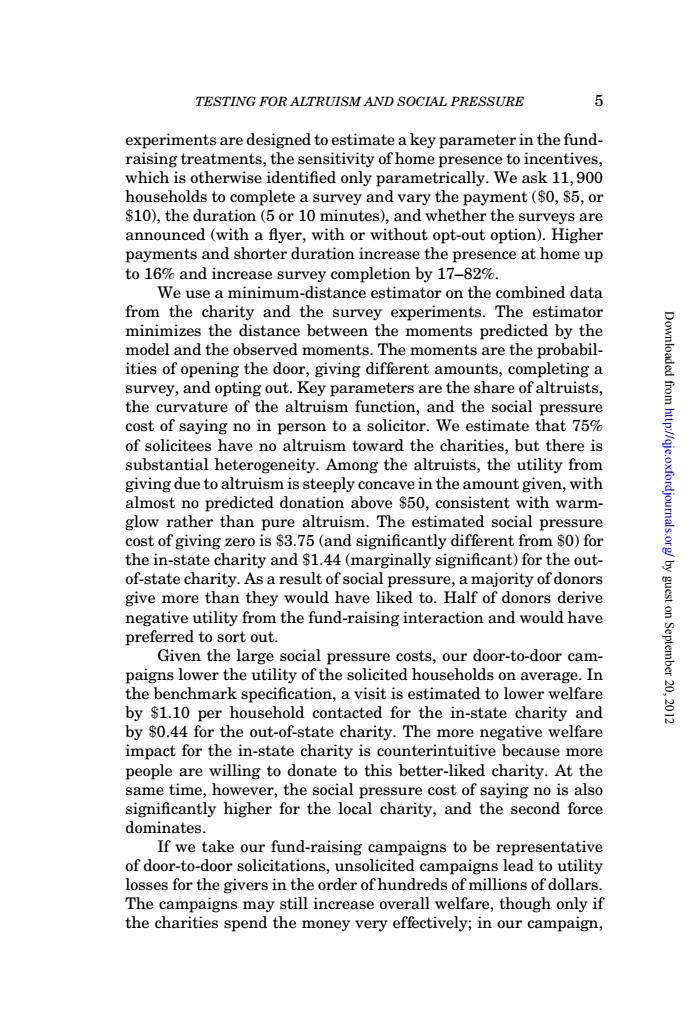正在加载图片...

TESTING FOR ALTRUISM AND SOCIAL PRESSURE experiments are designed to estimate a key parameter in the fund raising treatments,the sensitivity of home presence to incentives, which is otherwise identified only parametrically.We ask 11,900 households to complete a survey and vary the payment($0,$5,or $10).the duration (5 or 10 minutes).and whether the su announced a flyer, optout option).Higher payments and shorter duration increase the presence at home up to 16%and increase survey completion by 17-82%. we use a minimum-distance estimator on the combined data from the charity and the survey experiments.The estimator minimizes the distance betwe on the model and the moments predicted by obs ed moment he moments are the pre abil- ities of opening the door,giving different amounts,completing a survey,and opting out.Key parameters are the share of altruists, the curvature of the altruism function,and the social pressure cost of saying no in person to a solicitor.We estimate that 75% of solicitees have no altruism toward the charities,but there is tial h eroge Among the altr uists,the utility fro giving due to altruism is steeply concave in the amount given,with almost no predicted donation above $50,consistent with warm- glow rather than pure altruism.The estimated social pressure cost of giving zero is $3.75(and significantly different from $0)for the in-state charity and $1.44(marginally significant)for the out- of-state cha ity.As a result of s rity of do nors give more th an they would】 have f donors erive negative utility from the fund-raising interaction and would have preferred to sort out. Given the large social pressure costs.our door-to-door cam- paigns lower the utility of the solicited households on average n 6ys1.10 avisit is elfar per househe con od fo the in-state charity S044 for the out-of-state charity.The morev impact for the in-state charity is counterintuitive because more people are willing to donate to this better-liked charity.At the same time,however,the social pressure cost of saying no is also significantly higher for the loca al charity,and the ond force dominates If we take our fund-raising campaigns to be representative of door-to-door solicitations,unsolicited campaigns lead to utility losses for the givers in the order of hundreds of millions of dollars. The campaigns may still increase overall welfare,though only if the charities s spend the e money very effectively;in our campaign TESTING FOR ALTRUISM AND SOCIAL PRESSURE 5 experiments aredesignedtoestimateakeyparameterinthefundraising treatments, the sensitivity of home presence toincentives, which is otherwise identified only parametrically. We ask 11, 900 households to complete a survey and vary the payment ($0, $5, or $10), the duration (5 or 10 minutes), and whether the surveys are announced (with a flyer, with or without opt-out option). Higher payments and shorter duration increase the presence at home up to 16% and increase survey completion by 17–82%. We use a minimum-distance estimator on the combined data from the charity and the survey experiments. The estimator minimizes the distance between the moments predicted by the model and the observed moments. The moments are the probabilities of opening the door, giving different amounts, completing a survey, and opting out. Key parameters are the share of altruists, the curvature of the altruism function, and the social pressure cost of saying no in person to a solicitor. We estimate that 75% of solicitees have no altruism toward the charities, but there is substantial heterogeneity. Among the altruists, the utility from givingduetoaltruismis steeplyconcaveintheamount given, with almost no predicted donation above $50, consistent with warmglow rather than pure altruism. The estimated social pressure cost of giving zerois $3.75 (and significantly different from $0) for the in-state charity and $1.44 (marginally significant) for the outof-state charity. As a result of social pressure, a majority of donors give more than they would have liked to. Half of donors derive negative utility from the fund-raising interaction and would have preferred to sort out. Given the large social pressure costs, our door-to-door campaigns lower the utility of the solicited households on average. In the benchmark specification, a visit is estimated to lower welfare by $1.10 per household contacted for the in-state charity and by $0.44 for the out-of-state charity. The more negative welfare impact for the in-state charity is counterintuitive because more people are willing to donate to this better-liked charity. At the same time, however, the social pressure cost of saying no is also significantly higher for the local charity, and the second force dominates. If we take our fund-raising campaigns to be representative of door-to-door solicitations, unsolicited campaigns lead to utility losses for the givers in the order of hundreds of millions of dollars. The campaigns may still increase overall welfare, though only if the charities spend the money very effectively; in our campaign, by guest on September 20, 2012 http://qje.oxfordjournals.org/ Downloaded from